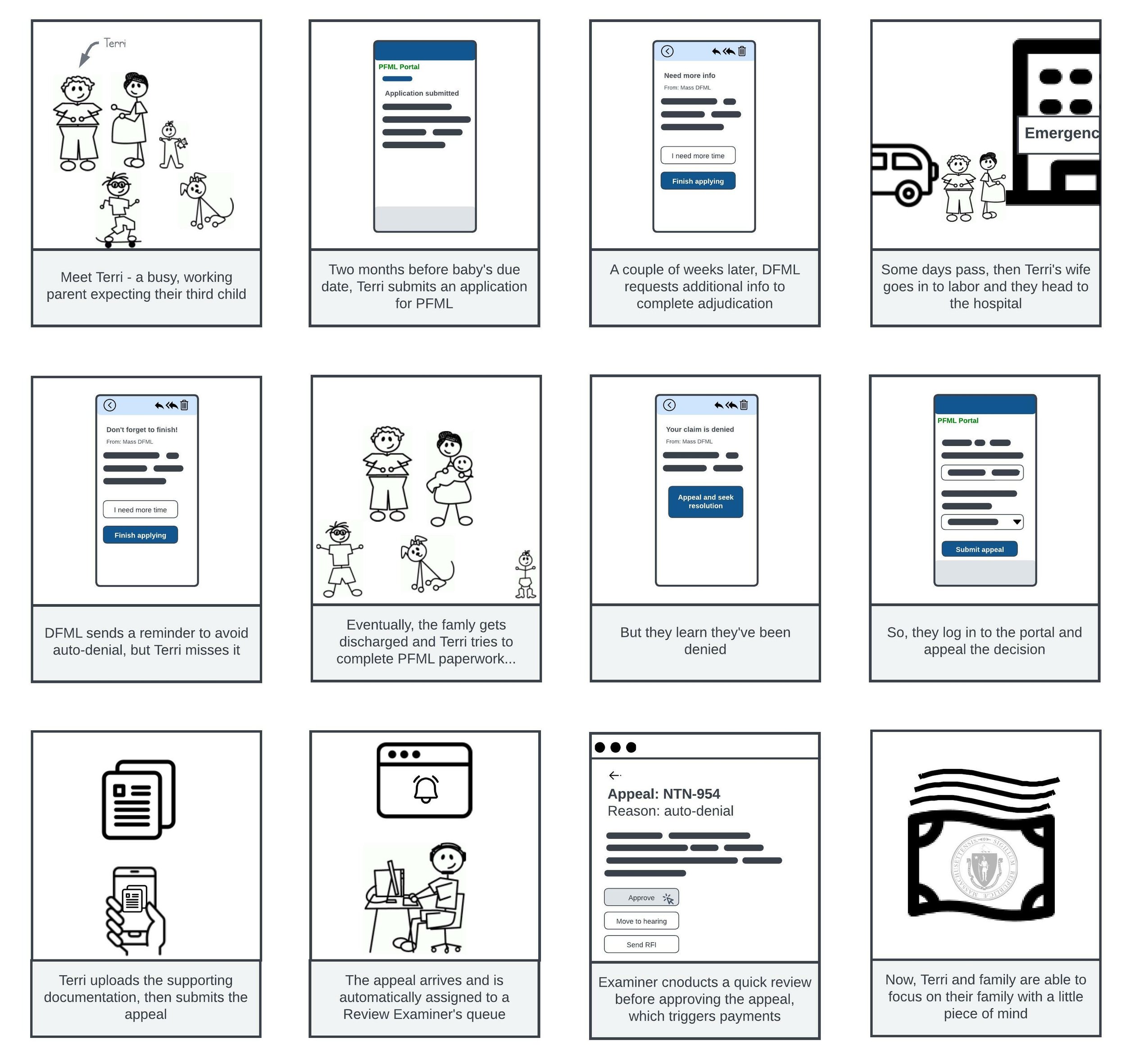
Appeals intake
The Massachusetts Department of Family and Medical Leave (DFML) took in roughly 2,500 appeal applications monthly. All of those applications required manual intervention before being reviewed. This meant a chunk of the Appeals team focus was dedicated to collecting the information rather than actually processing the claims.
Our goal was to automate the online application to streamline the intake process. My role as the Responsible Designer focused on crafting the claimant user experience in tandem with streamlining the business operations.
Context
Massachusetts’ Paid Family and Medical Leave (PFML) program launched January 1, 2021. One of the biggest program accolades was allowing claimants to apply online for benefits through the PFML Portal. The Department would review the application and make decisions if the leave should be approved – and if so, the length of leave and the calculated payout amount. If claimants disagreed with the approved length, benefit payout, or an outright denial, they could file an appeal.
Although Massachusetts’ PFML relied heavily on the PFML Portal for leave applications, applying for an appeal was limited to call, mail, or a standalone Formstack form. The form was digital, but it was not connected to the primary claims processing system.
So, the only way appeals entered the system to be processed was when an intake person would manually upload the data from Formstack (or a phone call or mail) into the system. As with all manual data entry, the process was slow and susceptible to error. Additionally, because the form was isolated from the primary claims processing system, there wasn’t any ability to verify the information claimants entered. A simple error – like an incorrect leave application number or a typo in their email address – could mean an appeal would be delayed or unable to move forward .
Due to these reasons, DFML hoped to retire the Formstack form.
Deciding on an approach
To fully understand the inner workings of how the sausage was made, we held conversations with the Appeals operations team to get a better understanding of how they approached the work. Through these conversations, observations, and interviews, we were able to identify plausible solutions, then weigh out the pros and cons of each solution.
|
|
Advantages |
Disadvantages |
|
In-portal appeal application |
|
|
|
Connect standalone form to Sharepoint |
|
|
|
Combination of the two above |
|
|
After evaluating the various trade-offs of the potential approaches, we ultimately decided to proceed with the in-portal appeal application for a handful of reasons:
The number of people who wouldn’t be able to apply online was less than 10%
Anyone that couldn’t apply online were still able to apply for an appeal by phone or mail
Substantially reduce the possibility of data entry issue from the claimant and the appeal intake specialist
Delivering the in-portal appeals application
The general solution was clear, but the details needed to be worked out. To start bringing more clarity to the challenge at hand, I crafted a narrative to unite the team behind a distinct vision.

This storyboard was foundational for multiple uses:
Reviewed flow and feasibility with Appeals Specialists
Provided early insight of the overall experience to the Engineers
Anchored Product conversations, simplifying the exchanges
Rallied the entire Product Team behind a specific goal
The vision gave the team a solid start and I continued to flesh out the details in mockups.






With the mockups, I created a prototype for usability testing. The biggest surprise from the research was the need to exercise trauma-informed research practices. Unlike user research with cheery participants, the applicants lived through some bleak situations. They were applying for leave because they were experiencing a significant life event such as managing their cancer or taking care of an ill loved one. Worrying about paperwork was the last thing they wanted to deal with. In the end, the research led to improvements to the interface, as well as grounding the team on the stakes at hand.
Launch
The feature launched August 2022 and in the first thirty days, the number of applications submitted via Formstack was 60% lower than the prior month. This change was greatly appreciated by the Appeals team, not just because it minimized menial work. But the best outcome was that the Appeals team had more capacity to focus on the hard problems that required more attention.